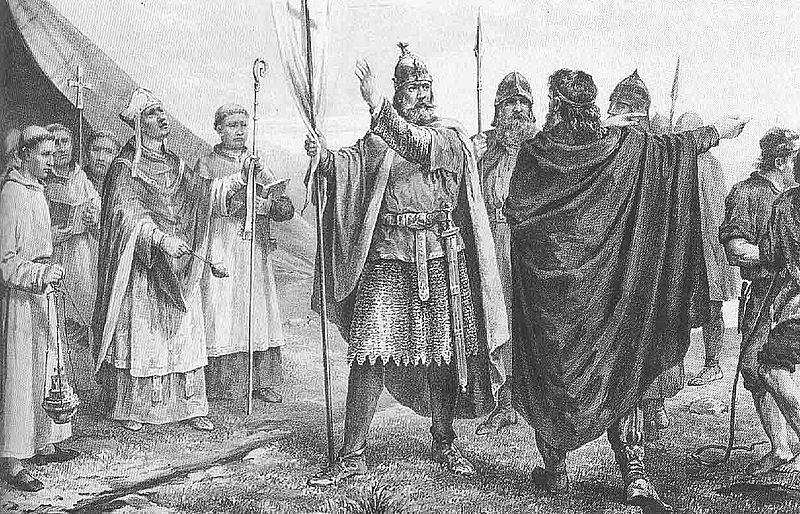A Tale of Two Olafs
Episode #9 of the course Vikings: History and mindset by Tom Shippey
Welcome to Lesson 9!
Yesterday, we covered the first two major battles for the unification. Today, we’ll talk about two more famous death scenes.
The drive for the unification of Norway caused two more great battles. In each, a missionary king was killed: Olaf I Tryggvason at Svold in the narrow channel between Denmark and Sweden in 1000, and Olaf II Sigurdsson (later, St. Olaf) at Stiklastadir not far from Hlaðir in 1030.

King Olaf I of Norway’s arrival to Norway. Based on drawing by Peter Nicolai Arbo (Norway 1831-1892).
Both had had similar Viking careers in youth. Olaf I was probably present at the Battle of Maldon in 991, famous because the defeated English fought to the death around their leader.
Olaf II helped the English king reconquer London, allegedly by pulling the piles from under London Bridge with his ships. Both kings claimed descent from Harald Fairhair and went back to win their heritage in Norway. Both also promoted Christianity, along with central government. That was the wave of the future.
Initial Success, Final Failure
Olaf I started off by dealing with Jarl Hakon of Hlaðir. Taken off guard, Hakon hid in an underground pigsty with his thrall, Kark. From there, both heard Olaf offering rewards for Hakon’s head.
In the night, Kark said he dreamed of Olaf putting a gold necklace around his neck. “It’ll be a red one, not a gold one,” said Hakon. Hakon did his best to stay awake but eventually fell asleep, and Kark cut his throat. Kark’s reward, as Hakon had warned, was to be beheaded, for treachery.
Olaf also took a hard line with unregenerate pagans. When the pagan leaders told him a king must make the traditional sacrifices, he said, “Yes. Human sacrifices. And not old worn-out thralls. Important people. Like you.” Those who still refused baptism were tortured to death.
His enemies eventually ganged up on him and ambushed him at Svold, probably in the narrows between Sweden and Denmark, where the decisive event was the clash between two famous longships: Olaf’s own “Long Serpent,” and “Ironbeard,” belonging to Jarl Eirik, son of Jarl Hakon.
One of the crew of “Long Serpent” was Einar Thambarskelfir, “shaker of the bow-string,” said to be a famous archer. But as he tried to shoot Jarl Eirik on “Ironbeard,” Einar’s bow broke. “What was that?” asked Olaf. “Norway breaking from your hand,” said Einar.
The story is rather spoiled by the fact that Einar’s nickname really means “Wobble-guts.” Olaf jumped overboard and was never seen again.
Death of a Skald
Thirty years later, Olaf II faced, as usual, the pagans of Hlaðir. Before the battle, his skald, Thormod, sang “The Old Lay of Bjarki,” a kind of suicide poem. Bad for morale? Olaf’s housecarls loved it.
Thormod also declared that he did not mean to survive if the king died, and was told, in effect, “Words are cheap. That’s up to you.”
It turned out not to be. Thormod survived the battle and the king’s death and was lamenting the fact when an arrow came from nowhere and struck deep. Thormod was pleased. He knew the dead king had sent it.
Thormod went to a dressing-station, where they were patching up both sides—they were all Norwegians, after all—and was offered garlic porridge for his body wound. You ate it, they sniffed the wound; if they could smell garlic, your gut had been pierced and you would die.
Thormod refused the porridge and pulled the arrow out himself. He then composed a poem but died on his feet without finishing it. Standing by, though, was teenage prince Harald Sigurdsson, King Olaf II’s half-brother and a great lover of poetry.
Has to be a verb, Harald thought, must have two syllables, must rhyme with this and half-rhyme with that, and also make sense … The missing word must be sviða, “cause pain.” Then Harald had to run for it. The victors were sparing Norwegians. But they might make an exception for yet one more descendant of Harald Fairhair.
Both Olafs, then, were masters of the Viking art of the snappy answer. Vikings were hard people to impress. What made them heroes was not victory, but the way they took defeat and death.
As would be true of skald-loving Harald, later called Hardrada, or Hard-Line Harald, the last Viking.
Tomorrow, we’ll talk about the end of the Viking Age.
Recommended reading
Share with friends
